Development
The company started to design a prototype fighter in the early 1920s, based on earlier wartime designs like the Zeppelin-Lindau D.I. It was an all-metal high-wing cantilever monoplane, with the wing above the fuselage on four small struts. It had a conventional cantilever tail unit and a fixed tailskid landing gear. The pilot had an open cockpit just behind the trailing edge of the wing. The aircraft was powered by a Hispano-Suiza piston engine located in the nose. Two aircraft were built by the Swiss subsidiary of Dornier and three by S.D.C.M.P. in Italy, [1] to avoid restrictions on military aircraft production in Germany. [2] It first flew on 1 November 1922, but failed to go into production. One of the Falkes was converted to a floatplane in 1923, powered by a 261 kW (350 hp) BMW IVa V-12 engine, as the Dornier Seefalke.
One Seefalke was shipped to the United States of America by the Wright Aeronautical Company, who fitted it with a licence-built Wright-Hisso H-3 engine. It was evaluated by the United States Navy with the designation Wright WP-1. [2] It performed well, but the Navy considered the monoplane fighter too advanced for its needs. [1]

The Mitsubishi A5M, formal Japanese Navy designation Mitsubishi Navy Type 96 Carrier-based Fighter (九六式艦上戦闘機), experimental Navy designation Mitsubishi Navy Experimental 9-Shi Carrier Fighter, company designation Mitsubishi Ka-14, was a WWII-era Japanese carrier-based fighter aircraft. The Type number is from the last two digits of the Japanese imperial year 2596 (1936) when it entered service with the Imperial Navy.
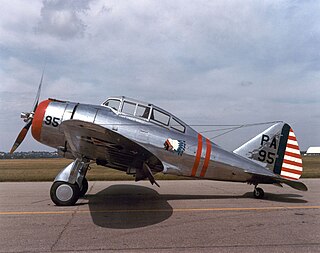
The Seversky P-35 is an American fighter aircraft built by the Seversky Aircraft Company in the late 1930s. A contemporary of the Hawker Hurricane and Messerschmitt Bf 109, the P-35 was the first single-seat fighter in United States Army Air Corps to feature all-metal construction, retractable landing gear, and an enclosed cockpit.

The Naval Aircraft Factory SBN was a United States three-seat mid-wing monoplane scout bomber/torpedo aircraft designed by the Brewster Aeronautical Corporation and built under license by the Naval Aircraft Factory in Philadelphia, Pennsylvania. The landing gear was similar to that on the Brewster F2A Buffalo fighter aircraft. The SBN had non-folding wings with perforated flaps.

The Stinson Reliant is a popular single-engine four- to five-seat high-wing monoplane manufactured by the Stinson Aircraft Division of the Aviation Manufacturing Corporation of Wayne, Michigan.

The Curtiss SC Seahawk was a scout seaplane designed by the Curtiss Aeroplane and Motor Company for the United States Navy during World War II. The existing Curtiss SO3C Seamew and Vought OS2U Kingfisher were gradually replaced by the Seahawk in the late stages of the war and into peacetime.

The Boeing Model 15 was a United States single-seat open-cockpit biplane fighter aircraft of the 1920s, manufactured by the Boeing company. The Model 15 saw service with the United States Army Air Service and with the United States Navy as a carrier-based fighter.
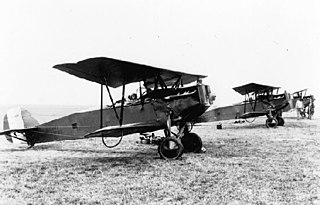
The Huff-Daland Type XV Training Water-Cooled TW-5 was a biplane trainer designed by the Huff-Daland Aero Corporation in the early 1920s for the United States Army Air Service.

The Kinner C-7 Envoy was an American four-seat cabin monoplane built by Kinner Airplane & Motor Corporation in the 1930s.

The Curtiss-Wright CW-22 was a 1940s American general-purpose advanced training monoplane aircraft built by the Curtiss-Wright Corporation. It was operated by the United States Navy as a scout trainer with the designation SNC-1 Falcon.

The Vought XSB3U was an American biplane scout bomber developed by Vought-Sikorsky for the United States Navy during the 1930s. Developed as an alternative to the SB2U Vindicator monoplane, the aircraft proved unsatisfactory to the Navy in comparison, and development was not pursued.
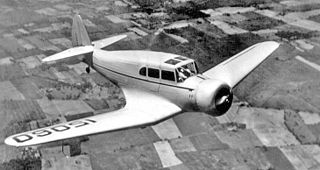
The Fairchild Model 45 was a 1930s American five-seat cabin monoplane aircraft designed and built by Fairchild.
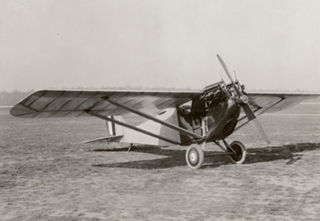
The Loening M-8 was a 1910s American fighter monoplane designed by Grover Loening and built by his Loening Aeronautical Engineering Company. The order for 5000 for the United States Army Air Corps was canceled when the First World War ended.

The Loening PW-2 was a 1920s American single-seat monoplane fighter designed by Grover Loening and built by his Loening Aeronautical Engineering Company.

The Seversky SEV-3 was an American three-seat amphibian monoplane, the first aircraft designed and built by the Seversky Aircraft Corporation.

The Northrop XFT was an American prototype fighter aircraft of the 1930s. A single engined low-winged monoplane, it was designed and built to meet a United States Navy order for an advanced carrier based fighter. It exhibited poor handling, and was rejected by the Navy, the single prototype being lost in a crash. A variant, the Northrop 3A, also was unsuccessful.

The Columbia XJL is a large single-engined amphibious aircraft designed by Grumman Aircraft but built by the Columbia Aircraft Corp. It was intended to replace the Grumman J2F Duck but the type did not reach production status.
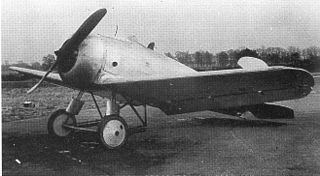
The Handley Page Type S, or HPS-1 was a prototype British carrier-based fighter developed for the United States Navy in the early 1920s. A low-wing monoplane, it was unsuccessful, only two being built and flown.

The Fokker PW-5 was a Dutch fighter aircraft of the 1920s. It was a parasol monoplane of which twelve were built for the US Army Air Service, being used as advanced trainers.

The Vought V-141 was a prototype American single-seat fighter aircraft of the 1930s. It was a development of the unsuccessful Northrop 3-A design, but was itself a failure, being rejected by the United States Army Air Corps. The sole prototype was sold to the Japanese Army in 1937, but no production followed, with the type proving to be inferior to existing Japanese fighters.

The Zeppelin D.I, or Zeppelin-Lindau D.I or Zeppelin D.I (Do), as named in German documents, also sometimes referred to postwar as the Dornier D.I or Dornier-Zeppelin D.I, for the designer, was a single-seat all-metal stressed skin monocoque cantilever-wing biplane fighter, developed by Claude Dornier while working for Luftschiffbau Zeppelin at their Lindau facility. It was too late to see operational service with the German Air Force (Luftstreitkräfte) during World War I.
This page is based on this
Wikipedia article Text is available under the
CC BY-SA 4.0 license; additional terms may apply.
Images, videos and audio are available under their respective licenses.




















